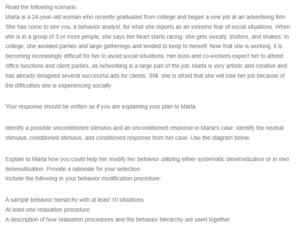Social Anxiety – Marla’s Case
In your case, Marla’s target behavior entails avoiding big social parties, events, or gatherings. This kind of avoidance often implies that your behavior is affected by the surrounding events that probably happened in the past and are still lingering in your mind. In this case, the condition stimuli involve the client parties and the official events that must be attended to increase networking. Your condition response is shaking, shuttering, racing heart, and sweating. The identified neutral stimuli are client parties and office functions. The unconditioned stimuli entail big social gatherings and parties, whereas the unconditioned response is fear of avoiding the social environment. According to Miltenberger (2015), respondent conditioning refers to the matching effect on someone’s behavior and is often controlled by response conditioning, antecedent stimuli, and antecedent stimuli manipulation.
In your case, the respondent’s behavior has occurred because of the presentation of the unconditional stimuli. For example, when one passes a finger across your eyes, your unconditioned response would be to blink. From the case scenario, what really causes your anxiety around the social environment is unknown. However, we shall apply systematic desensitization.
Systematic desensitization is a process through which an individual who experiences fear and anxiety practices relaxation as they imagine the scenes of stimulus that produce fear (Miltenberger, 2015). In this case, it will help you substitute fear with a response of relaxation to the conditional stimuli presented by your colleagues and boss. I would allow you to sit and listen to the scenario where I have seen a cockroach 30 feet away from you. I will monitor your relaxation process and let you know how far the cockroach gets as it approaches you. The aim is to maintain a relaxed response while you imagine the stimulus producing fear in you (Miltenberger, 2015).
I would develop a fear-producing hierarchy as soon as you learn the relaxation process. On a scale of 0 to 10, I would rate 10 as feeling the most fear when the cockroach is on your arm, 7 when it is 15 feet away, 5 when it is 20 feet away, and 0 (least fear) when it is 30 feet away. For example;
- Cockroach 0 feet away from Marla- 10
- 1 foot away- 9
- 2 feet away- 8
- 3 feet away- 7
- 4 feet away- 6
- 5 feet away- 5
- 6 feet away- 4
- 7 feet away- 3
- 8 feet away- 2
- 10 feet away- 0
I would be asking to relax every time the cockroach approaches. I would repeat the scene to ensure that you imagine the scenes and maintain relaxation throughout the scenes in the hierarchy. Essentially, this process was chosen because it prepares you to face anxiety before you actually encounter real events. In the real events, you would remember the practice exercises just like you remembered the anxious episodes previously experienced in the social setting that prompted the fear. In this hierarchy, increasing the proximity of the stimulus within the range of most feared and least feared circumstances helps get you used to it and allows anxiety to subside (Cooper, Heron, Heward, 2019).
References
Cooper, J. O., Heron, T. E., & Heward, W. L. (2019). Applied Behavior Analysis. 3rd Edition. Pearson UK.
Miltenberger, R. G. (2015). Behavior Modification: Principles and procedures, 6th Edition. Boston: Cengage Learning.
ORDER A PLAGIARISM-FREE PAPER HERE
We’ll write everything from scratch
Question

Social Anxiety – Marla’s Case
Read the following scenario.
Marla is a 24-year-old woman who recently graduated from college and began a new job at an advertising firm. She has come to see you, a behavior analyst, for what she reports as an extreme fear of social situations. When she is in a group of 3 or more people, she says her heart starts racing, she gets sweaty, stutters, and shakes. In college, she avoided parties and large gatherings and tended to keep to herself. Now that she is working, it is becoming increasingly difficult for her to avoid social situations. Her boss and co-workers expect her to attend office functions and client parties, as networking is a large part of the job. Marla is very artistic and creative and has already designed several successful ads for clients. Still, she is afraid that she will lose her job because of the difficulties she is experiencing socially.
Your response should be written as if you are explaining your plan to Marla.
Identify a possible unconditioned stimulus and an unconditioned response in Marla’s case. Identify the neutral stimulus, conditioned stimulus, and conditioned response from her case. Use the diagram below.
Explain to Marla how you could help her modify her behavior utilizing either systematic desensitization or in vivo desensitization. Provide a rationale for your selection.
Include the following in your behavior modification procedure:
A sample behavior hierarchy with at least 10 situations
At least one relaxation procedure
A description of how relaxation procedures and the behavior hierarchy are used together

